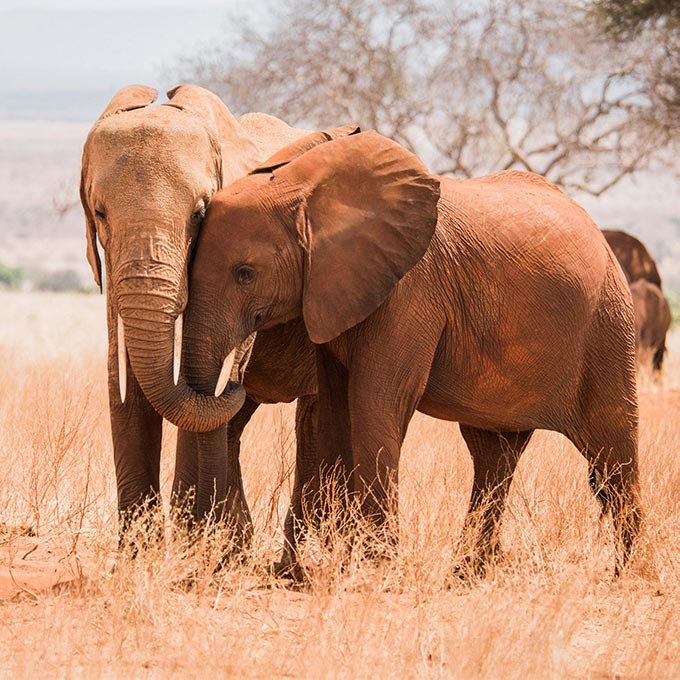Get to Know The Sheldrick Wildlife Trust
Pioneering conservation and the protection of wildlife and habitats in East Africa

GoMacro is excited to introduce our newest addition to our Give Back Bar program, Sheldrick Wildlife Trust! Best known for its Orphans' Project, the first and most successful elephant orphan rescue and rehabilitation program in the world, the organization has been pioneering conservation and the protection of wildlife and habitats in East Africa since the 1970’s. We spoke to Melissa Sciacca, Executive Director of the Sheldrick Wildlife Trust, about the greatest threats to wildlife populations, what goes into raising a baby elephant, and how we can all contribute to a world where humans and these magnificent species can coexist.
- 1. Sheldrick Wildlife Trust’s best-known initiative is the renowned elephant rescue program, the Orphans’ Project. What has made this program so successful and what are the wider, systemic impacts of rescuing these orphaned animals?
A great deal of our success comes from the simple fact that over time we learned through trial and error before getting our processes right. Daphne (Sheldrick) began raising orphaned animals—everything from rhinos and elephants to little impala and dik diks—long before the beginning of the Sheldrick Wildlife Trust, so it is the decades of experience that have brought us to where we are today.
Much of our success comes from understanding the intricate needs of an elephant, who are incredibly delicate beings. We feed them a specialized milk formula around the clock, provide a surrogate family for each orphan- both human and elephant- and work within each animal’s own time table for recovery. We cater to each individual need of every elephant we care for, and our patience and dedication is largely what makes our long term success possible
The systemic impacts stem from providing a future and life for an elephant, one animal at a time. We have aided over 250 elephants in our time, many of which have gone on to live wild lives and are now having wild-born families of their own. We recently welcomed our 36th wild-born elephant calf to one of our previously graduated orphans, so it is in those new lives that we see our mission and purpose come full circle.
- 2. How are orphaned animals found and what’s typically required to raise them to the point that they’re ready to be released back into the wild?
Orphans are found in a variety of ways. Sometimes they fall victim to poaching, where their mothers have succumbed to a poacher’s snare, a poisoned arrow, or sometimes even much worse, such as a gunshot wound. Other times they are found having been stuck in a well where the herds, unable to rescue their calf on their own, must make the heartbreaking decision to move on and leave the calf behind for the safety of the other herd members.
More recently, we are seeing orphans due to climate change. When drought occurs and there is little food to be found, calves are left to fend for themselves when their mothers succumb to dehydration or starvation and pass away. Elephant calves are much like human infants in that they need a regular supply of milk every few hours. A baby elephant cannot possibly survive on its own in its early years, so we must step in to help and raise the orphans so that they may once again have a chance at wild life.
Besides milk, elephants are extremely emotional animals. It is not enough to simply provide for their physical needs, we must nurture their emotional well-being as well. We have lost elephants who simply lost the will to live and died of a broken heart after losing their families. So we must ensure they are given all the love, attention, and affection possible from both the human keepers that care for them and the other orphaned elephants who become their new family.
Typically once an orphan arrives, the immediate focus is to stabilize them and get them hydrated as quickly as possible. Once they are settled, we offer milk, and then as soon as we can- we introduce them to the other orphaned elephants who immediately welcome the new charges and help them to feel comforted and safe in their new surroundings. Orphans at an infant stage must be fed every 3 hours, much like human babies, so keepers stay with them 24 hours a day, even sleep with them, to ensure their every need is met. It’s approximately 3 years before they are moved down to the reserve to one of our reintegration units. This is where they join other older orphaned elephants and begin intermixing with graduated orphans and wild elephants. When they are ready, they will choose to go wild, and we support them 100% until they make their choice to leave our care.
- 3. Dame Daphne Sheldrick once called elephants “the world’s most emotionally human land mammal.” Do the Keepers at the nurseries notice distinct personalities among the orphans?
Absolutely. Once you have the chance to spend a little time with the orphans, it’s quickly apparent that no two elephants are the same. Some are more introverted and cautious, while others are boisterous, confident, and downright naughty! Each one has their own personality, yet all find a way to work together to mesh within the dynamics of the herd.
- 4. Sheldrick Wildlife Trust takes a very holistic approach to conservation efforts. Along with the Orphans’ Project, what are some of the other programs that have been most effective in creating a better future for wildlife in Kenya?
After four decades of conservation practices, the Sheldrick Wildlife Trust has come to understand that the only real and lasting solution for wildlife is a comprehensive approach to conservation. It is not enough to simply invest 8-10 years hand raising a baby elephant if you are turning them out into an unstable wilderness that cannot sustain them. This is why we have developed a total of six key conservation programs that all work together to advance the future of wildlife.
These include:
- Orphans’ Project
- Anti-poaching Operations
- Aerial Surveillance
- Habitat Preservation and Water for Wildlife
- Mobile Veterinary Units
- Community Outreach/Education
Our anti-poaching program consists of deploying teams of six rangers with actual boots on the ground to track poaching activity and mitigate any possible threat to wildlife. It also includes ivory or bushmeat poaching, snare removals, as well as damage to the larger ecosystem such as charcoal burning, wildfires, and much more. In tandem with this program is our aerial surveillance unit which acts as our eyes in the sky to assist our ground teams. Our dedicated team of pilots fly daily to ensure all is in order and continue the safety of wildlife and wild places in the areas we work.
We also have five dedicated mobile veterinary units which are deployed in various parts of Kenya to medically assist and treat wildlife that may not need a full rescue, but do need immediate medical intervention. This project in particular has been quite impactful, with nearly 7,000 cases attended to since its inception There is far more that the Trust does including Habitat Protection and community outreach as well.
- 5. Although the organization is named for the late David Sheldrick, the whole Sheldrick family has been integral in wildlife conservation efforts in Kenya’s Tsavo National Park and beyond since well before its founding. How did Sheldrick Wildlife Trust get its start and how have efforts evolved in recent years?
David Sheldrick was the original warden of Tsavo National Park, and together they helped shape Tsavo into the wilderness that it is today. David passed unexpectedly in the late 70’s, and in 1977 Daphne, in his memory and honor, decided to create The David Sheldrick Wildlife Trust to continue his legacy in wildlife conservation. Daphne is world renowned for her efforts in hand raising orphaned elephants and rhinos, as well as any other small creature that came along in need of help. She was the first person to perfect the milk formula that enabled a human to care for an orphaned elephant and successfully raise an orphan to adulthood.
Her work has established a blueprint for the Trust to carry on for generations to come, and is now led by her daughter, Angela Sheldrick who has equally helped bring the work of the Trust into the forefront of conservation initiatives around the world. Angela’s two sons are also deeply integrated into the fold, serving as pilots for the Trust, and will continue to be a part of the organization’s development and growth in future years.
- 6. What are some of the greatest challenges facing wildlife and habitats in Kenya, and how can people get involved in promoting conservation efforts?
Elephants and wildlife as a whole face a great number of threats in today’s world - all essentially at the hands of humans. While poaching still remains a threat, and perhaps even more so now that the Covid-19 pandemic has forced many to look for alternative sources of income, the biggest problem is human/wildlife conflict. As the human population continues to grow and push up against those boundaries of community land/wildlife reserves, the competition for space is felt more acutely. Finding ways in which humans and wildlife can co-exist is our biggest challenge to saving not only both human and animal lives, but also to preserve the wild spaces that elephants and wildlife have to live in.
The best way for people to get involved is to not only learn about the challenges facing wildlife today, but to share the stories and issues within their networks. Spreading knowledge about the work of Sheldrick Wildlife Trust, or simply sharing a story about one of SWT’s elephant orphans can go a long way in bringing elephant and wildlife conservation to the forefront of people’s minds. Secondly, financial support is always needed to keep our life-saving projects operational. Any amount of donation is appreciated, although it’s wonderful to adopt an elephant for $50/year where you pick an elephant to help support and get monthly updates and access to information as a part of the program.
- 7. As human activity increasingly impacts wildlife in the areas where you work, what keeps the Sheldrick Wildlife Trust team motivated to continue this important work?
Our Founder, Dame Daphne Sheldrick once said, “All life has but one home, the earth, and it is our job as the dominant species to protect it.” These words galvanize us every day to keep moving forward with our duty to do what we can to ensure wildlife has a place here, and that they deserve to have a quality life the same as we do. For over 40 years we have seen the positive and tangible results of our efforts. Knowing that each life we save contributes to the overall progress of our mission makes our job worthwhile and necessary for future generations to have the same opportunity to coexist alongside some of the world’s most magnificent species.
Looking for another way to support the innovative conservation work of Sheldrick Wildlife Trust? Enjoy a new Double Chocolate + Peanut Butter Chips MacroBar! Annually, during the month of August, 10% of net proceeds from GoMacro’s Smooth Sanctuary MacroBar are donated to the non-profit organization.



